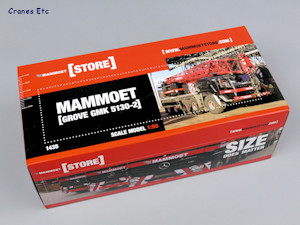 | | Mammoet box. |  | 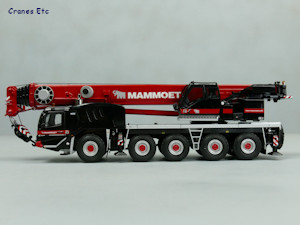 | | Profile view. | 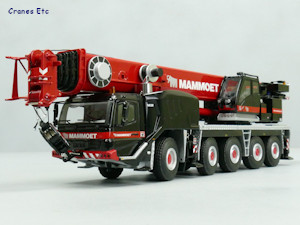 | | Usual smart Mammoet livery. | 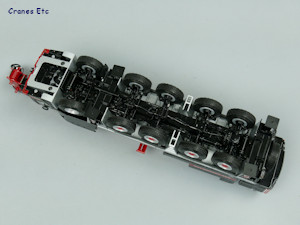 | | Detailed chassis. | 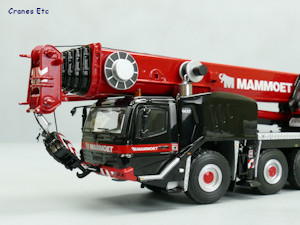 | | The hook does not hang straight on the tie-on as it has a fixed orientation. | 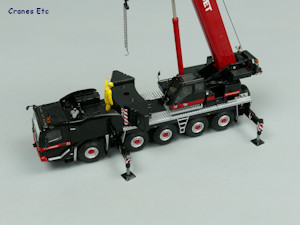 | | Loading the ballast. The lifting lugs on the plates are not useable. | 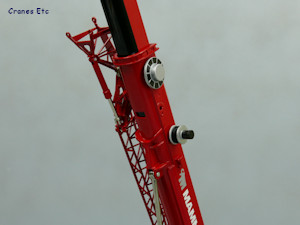 | | Spooling drums on the boom. | 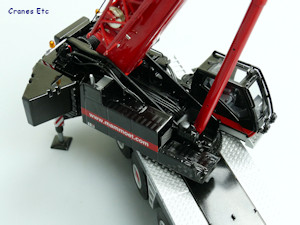 | | Hydraulic hoses add detail. | 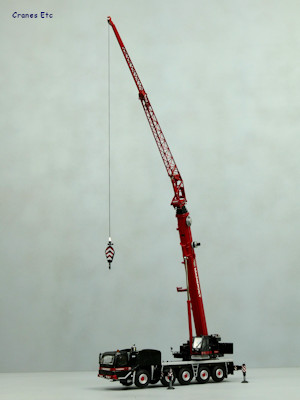 | | Fly jib rigged. | 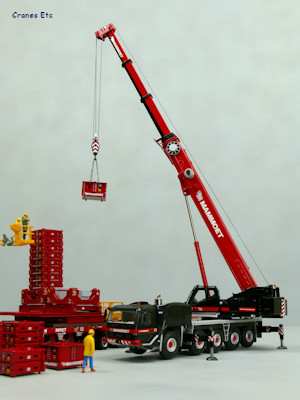 | | Poses well with other models. | 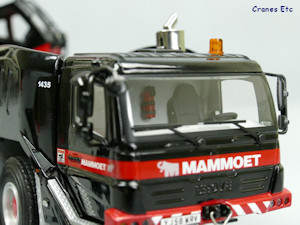 | | Fire extinguisher in the cab. |
|  Comment on this model. Comment on this model.
The Grove GMK5130-2 is a five axle crane rated at 130 tonne capacity. It has a 60m main boom, with up to 32m of fly jib.
The model is in the colours of Mammoet, the worldwide lifting engineering company.
Packaging
This model comes in a Mammoet branded box which has a photo of the real crane. Inside, the model is held within expanded polystyrene trays with some additional soft packing.
The review model had no missing parts. However the exhaust pipe was loose in the box, but easily refitted, and the hook was reeved wrongly.
The model comes with a small version of the Grove product guide which has plenty of information on the real crane. Also included is a Mammoet Certificate card.
Detail
Underneath, the chassis is very detailed with excellent metal transmission and axles, and hoses running to each wheel. Engine details are also present. The wheels have hard rubber tyres and they are mounted on decorated plastic rims.
The outrigger beams and pads are metal although the beams themselves are single castings and so do not replicate the two stage nature of the real outriggers. There are warning notices and legs which when extended look like pistons instead of screw threads.
At the front, the driving cab is of a high standard. Inside the detail is very good, with clearly visible instruments, and a fire extinguisher. On the outside there are some thin metal mirrors which have to be fitted. Textured steps lead to the cab. A loop for attaching the hook during transport is provided and an orange beacon light and a realistic number plate completes the detail on the cab.
The carrier deck has a diamond patterned walkway surface and behind the driving cab there is a very fine fuel tank with electric cabling, and a nice exhaust pipe with a mesh grille. At the rear there is a spare tyre, fixed ladders and wheel chocks, and painted light clusters.
The crane cab is good, with wipers, mirrors and lights. There is an array of hydraulic hosing which runs to the slewing motors and winches. There is a mirror on the top of the crane body that gives visibility of the winch to the operator but it remains folded in the transport position and cannot be altered.
The counterweight is made up of a series of separate slabs and they each have tabs for lifting chains. Two wing blocks slot into place, but they cannot be posed being lifted.
The main lift cylinder for the boom is plastic, and the six section main boom is metal. The lowest section contains some detail within the casting and a couple of spooling drums. One of these is wound with thread to represent cabling although it is non functioning. At the boom head there is a block of eight pulleys which is all a single piece so a large multi-line hook would not run smoothly.
The metal lattice fly jib is very nicely made with fine casting and some excellent pulleys.
One hook block is supplied and they are metal with a single block of three sheave.s The tie off point on the hook appears over large for the scale. A single line hook block might have looked better on the fly jib.
Features
The suspension on the model is very good and functions with each wheel individually sprung. The steering mechanism links axles 1 and 2, and axles 4 and 5. Axle 3 does not steer, unlike the real crane, so it is not possible to pose crab steering. Also it is not really possible to obtain a hard lock on the steering as tyres start fouling the wheel arches.
The outriggers extend but not as much as might be expected as they are a single casting rather than two stage, but they are robust enough to hold the weight of the model.
On the carrier deck is an opening equipment chest.
The crane cab tilts to an angle of around 30°.
The counterweight is removable by carefully undoing two screws on the underside and this gives many more display options for the crane including showing a realistic travelling mode, or displaying the crane carrying out self ballasting.
The crane rotates nicely. The boom can be raised and the cylinder is stiff enough to hold steeper angles. Two holes in the ram jacket allow pinning to prevent sagging. Boom sections telescope and lock smoothly.
The lattice jib can be pinned into place and three combinations are possible; short, medium and long, with each one able to be set at a variable offset angle using the hydraulic cylinder.
The winch does not have a brake so will not hold a load unless a wedge is inserted.
Quality
This is high quality model with a high metal content.
The paint and graphics represent the Mammoet livery very nicely.
Price
The model is moderate value for a sought-after limited edition.
Overall
This model appears to be derived from previous TWH models. It is a nice model with some aspects a little dated such as the outrigger beams and solid pulley blocks. As with so many models, it looks great in Mammoet colours.
Footnotes
|
|  | |
| 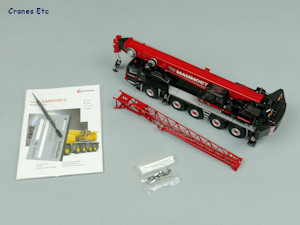 | | The parts. | 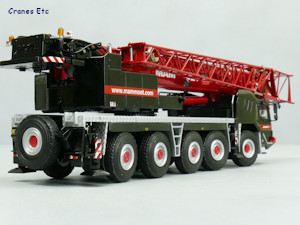 | | Wheels are smart. | 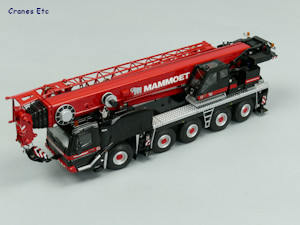 | | Looks good on the road. | 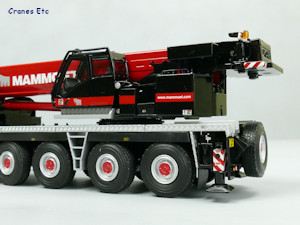 | | Rubber skirts above the wheels. | 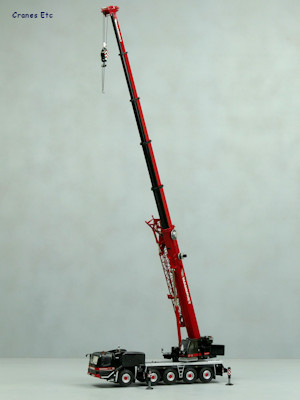 | | Ready for work. | 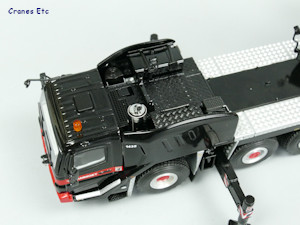 | | Behind the cab there is an opening tool box. | 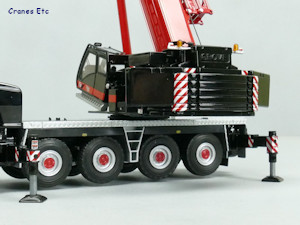 | | Tilting cab. The outriggers can lift the crane 'wheels-free. | |
| 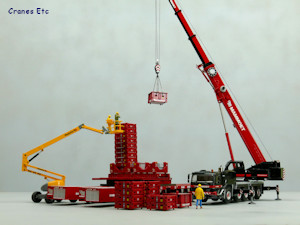 | | Assembling an SPMT layout. | 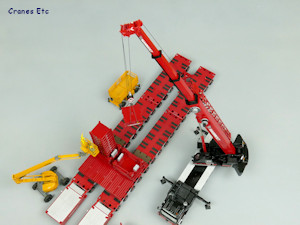 | | Busy work site. | 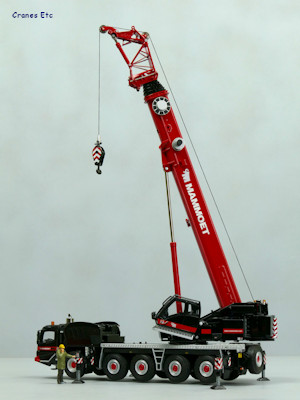 | | Rigged with a short fly jib. |
|

